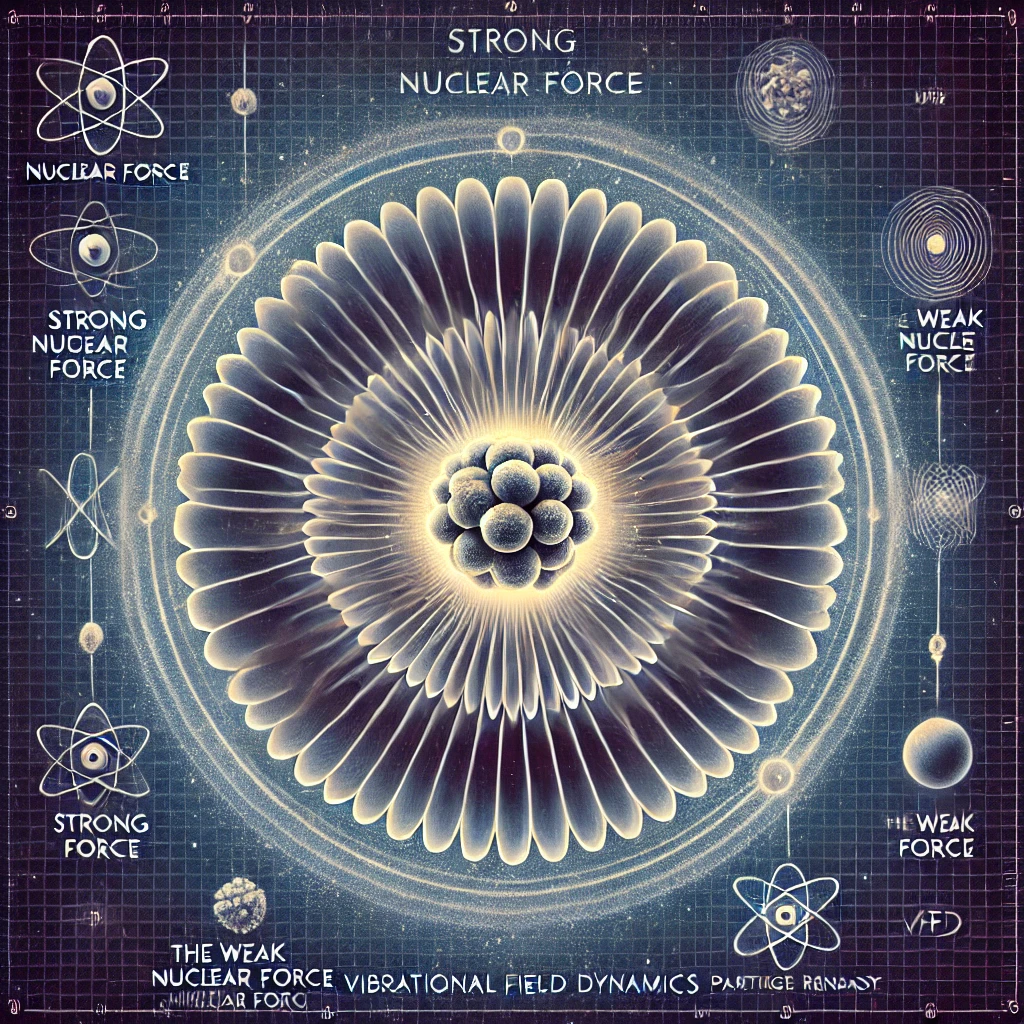Rethinking Nuclear Forces Through Vibrational Field Dynamics

In Vibrational Field Dynamics (VFD), the fundamental forces that govern atomic stability—the strong and weak nuclear forces—are understood as interactions within a vibrational field rather than as isolated forces. VFD proposes that the stability and transformation of atomic nuclei emerge from vibrational resonance and frequency alignment within this unified field. This perspective redefines these nuclear forces through concepts of vibrational harmony and resonance patterns, offering a fresh lens to explore their roles in atomic structures.
The Strong Nuclear Force as a Resonant Binding Frequency
In traditional physics, the strong nuclear force is what binds protons and neutrons tightly within an atomic nucleus. This force is incredibly powerful but acts only over short distances, holding the nucleus together against the repulsive force of positively charged protons.
In VFD, the strong nuclear force can be understood as a resonant binding frequency. Protons and neutrons vibrate at unique frequencies that resonate within a specific range of alignment. When these subatomic particles are within close proximity, their frequencies interact constructively, creating a resonant binding effect that “locks” them together. This resonance provides the cohesive force that stabilizes the nucleus, countering the repulsion between protons.
Analogy: Imagine a group of singers standing close together, harmonizing in a way that amplifies their voices. The resonance between their voices creates a powerful, unified sound. In the same way, protons and neutrons, when vibrating in close alignment, generate a resonant frequency strong enough to bind them together, even against the repelling forces between protons.
Nuclear Stability and the VFD Field Gradient
According to VFD, atomic stability results from particles within the nucleus aligning at specific frequencies that resonate with the vibrational field’s gradient around them. This gradient creates a natural boundary that allows particles within a nucleus to maintain a stable resonant state without dispersing. When resonance is disrupted (such as in larger atoms where particles become misaligned), the nucleus becomes unstable, leading to radioactive decay or fission.
Analogy: Consider a drum skin that vibrates in harmony when struck in the center, but if struck near the edges, the sound becomes distorted and unstable. Similarly, particles in a stable nucleus align within the VFD field’s gradient, while those on the “edges” or in larger nuclei lose this alignment, resulting in instability.
The Weak Nuclear Force as a Vibrational Transformation Mechanism
The weak nuclear force is responsible for radioactive decay and particle transformations, like converting neutrons into protons. Traditionally, it’s viewed as a force that facilitates changes within particles and drives decay processes.
In VFD, the weak nuclear force is reinterpreted as a vibrational transformation mechanism. Instead of acting directly on particles, the weak force is an effect of the vibrational field reconfiguring the frequency alignment within a particle. When resonance within a particle becomes unstable or misaligned, it transforms, shifting between states (such as neutron to proton) in a process that we observe as decay. This realignment within the VFD field drives changes in the particle’s vibrational signature, transforming its nature.
Analogy: Imagine a spinning top that, when perfectly balanced, spins in a stable state. Over time, it slows and wobbles, eventually tipping and changing orientation. In VFD terms, particles in a nucleus experience a similar “wobble” when their frequencies lose alignment, leading to transformation or decay as they seek a new resonant balance.
Particle Decay as a Realignment Process in the Field
In VFD, radioactive decay is the outcome of particles realigning within the vibrational field. When an atom’s nucleus becomes too large or its particles misalign with the resonant field, they lose stability. The field then “reconfigures” the misaligned particles, causing decay and the release of energy, which we observe as radiation. This transformation releases energy in a way that reflects the field’s attempt to restore balance.
Analogy: Consider a group of dancers moving in sync with a rhythm. If one dancer becomes out of step, they naturally readjust to fall back in line, or they may step out entirely. In a similar way, particles in a nucleus that lose vibrational alignment either decay to reconfigure or are released from the nucleus, releasing energy in the process.
Summary: The Strong and Weak Nuclear Forces in VFD
In the Vibrational Field Dynamics model, nuclear forces are reinterpreted through the principles of resonance and vibrational alignment:
- Strong Nuclear Force: A resonant binding frequency that holds protons and neutrons together within the nucleus through vibrational alignment.
- Nuclear Stability: Particles in the nucleus align with the field gradient, maintaining stability through resonance within a specific boundary.
- Weak Nuclear Force: A vibrational transformation mechanism that facilitates particle transformations by reconfiguring misaligned frequencies.
- Particle Decay: An outcome of realignment within the vibrational field, where unstable particles release energy to restore balance.
This reimagining of nuclear forces highlights their origin in resonance, alignment, and transformation within a unified vibrational field. VFD provides a framework that links the stability and changes within atomic nuclei to vibrational principles, offering a cohesive and unified view of nuclear forces.



Leave a Reply